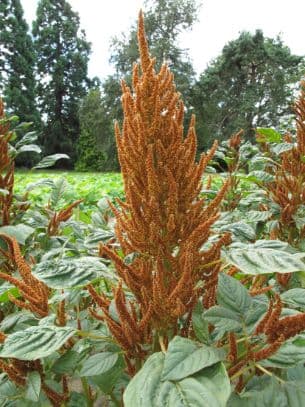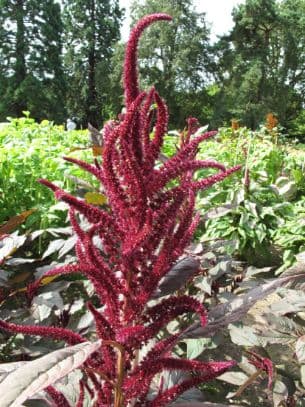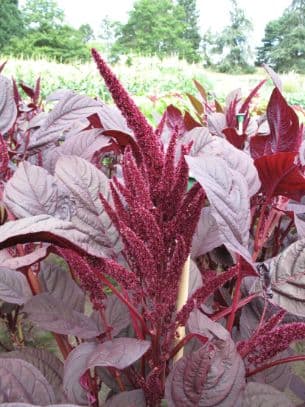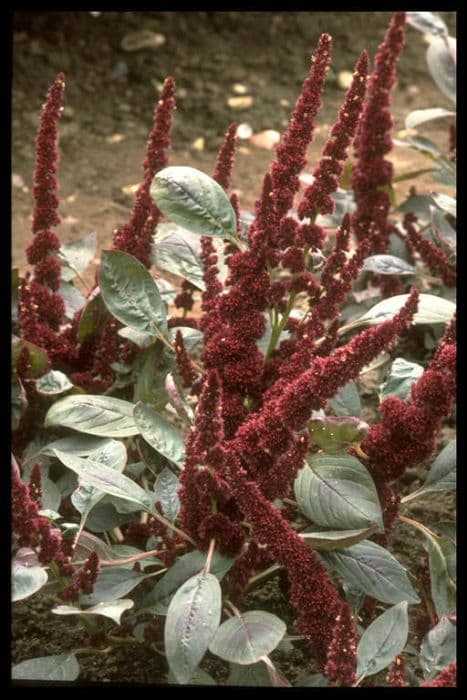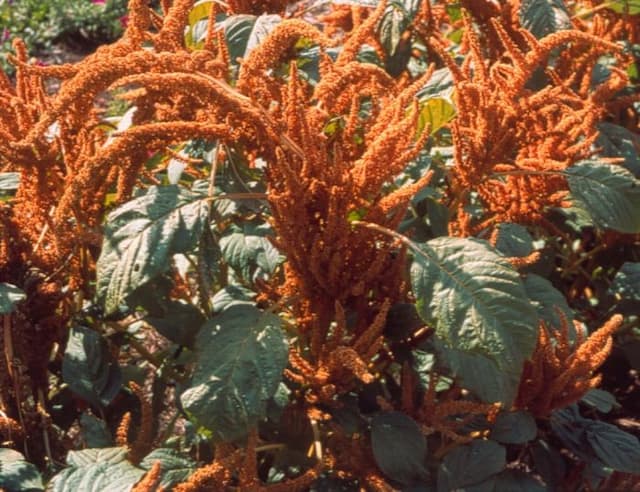Love-lies-bleeding Amaranthus 'Red Army'

ABOUT
Amaranthus 'Red Army' is distinguished by its striking dark red foliage, which can range from a deep burgundy to an almost maroon hue. The leaves are typically elongated and lance-shaped with a smooth texture and often exhibit a glossy sheen that highlights their intense color. Stems of the 'Red Army' are sturdy, supporting the weight of the leaves and sometimes mirror the red pigmentation, enhancing the plant's overall dramatic appearance. As a member of the amaranth family, the plant may produce feathery flower spikes that stand in stark contrast to the foliage, with a reddish or crimson tone that adds to its ornamental appeal. The contrast between the richly colored leaves and the striking flower spires lends an air of opulence and visual warmth to any garden setting where this variety is featured.
About this plant
 Names
NamesFamily
Amaranthaceae.
Synonyms
Red Army Amaranth, Love-Lies-Bleeding, Tassel Flower, Velvet Flower, Foxtail Amaranth.
Common names
Amaranthus paniculatus, Amaranthus cruentus, Amaranthus hybridus var. cruentus.
 Toxicity
ToxicityTo humans
Amaranth, including the variety 'Red Army', is not known to be toxic to humans. In fact, many parts of the plant, such as leaves and seeds, are edible and nutritious. The plant contains proteins, vitamins, minerals, and essential amino acids. However, the raw leaves may contain oxalates, which can cause issues for individuals with kidney disorders or those susceptible to kidney stones if consumed in large quantities. It's usually recommended to cook the leaves to reduce the oxalate content.
To pets
Amaranth is not generally considered toxic to pets. However, like in humans, the raw leaves contain oxalates, which can be harmful to pets in large amounts, potentially causing issues such as kidney stones or renal failure. As a precaution, it is advisable to prevent pets from ingesting large amounts of the plant, especially if they have a history of kidney problems. Cooking the plant can reduce the oxalate levels and make it safer for consumption.
 Characteristics
CharacteristicsLife cycle
Annuals
Foliage type
Deciduous
Color of leaves
Red
Flower color
Red
Height
3-4 feet [91-122 cm]
Spread
1-2 feet [30-61 cm]
Plant type
Herb
Hardiness zones
2-11
Native area
Tropical Americas
Benefits
 General Benefits
General Benefits- Ornamental appeal: Amaranthus 'Red Army' adds a striking visual element to gardens with its deep red foliage and architectural height.
- Drought tolerance: Once established, this plant is resilient in dry conditions, making it suitable for xeriscaping.
- Easy to grow: Amaranthus is known to be low maintenance, requiring minimal care to thrive.
- Attracts wildlife: The seeds produced by Amaranthus can attract birds and beneficial insects.
- Edible parts: Some parts of the plant, like the leaves and seeds, are edible and can be used in various culinary applications.
- Heat resistance: This plant can withstand high temperatures, making it ideal for warm climates.
- Soil adaptability: Amaranthus 'Red Army' can grow in a wide range of soil types, including poor soils.
- Fast growth: Amaranthus plants generally have a rapid growth rate, allowing for quick establishment in the garden.
- Non-invasive: Unlike some other Amaranthus species, 'Red Army' is less likely to become invasive and can be managed easily in a garden setting.
 Medical Properties
Medical Properties- Antioxidant properties: Amaranthus spp. are known to contain compounds such as flavonoids and phenolic acids that have antioxidant effects.
- Anti-inflammatory effects: Amaranthus species might have anti-inflammatory properties useful in reducing inflammation.
- Nutritional supplement: Leaves of Amaranthus plants, rich in vitamins and minerals, could potentially support overall health.
- Immune support: Amaranthus species may contribute to the support of the immune system due to their nutritional content.
 Air-purifying Qualities
Air-purifying QualitiesThis plant is not specifically known for air purifying qualities.
 Other Uses
Other Uses- Amaranthus 'Red Army' can be used as a natural dye, offering a range of pink, red, and purple hues for textiles and craft projects when the leaves and stems are processed correctly.
- The plant's vibrant leaves are sometimes incorporated into floral arrangements or used as a natural confetti at eco-friendly events.
- Red Amaranth flour, made by grinding the seeds, can be used in gluten-free baking recipes, providing a nutritious and colorful alternative to traditional flours.
- The striking red leaves can serve as a natural indicator of pH in educational science experiments, changing color in response to different pH levels.
- It can be grown as a companion plant in vegetable gardens to attract beneficial insects and deter certain pests.
- As a visual cue for spatial planning in garden design, Red Amaranth can be placed to create contrasting color schemes or highlight certain areas due to its vivid coloration.
- In the art world, the leaves and stems can be pressed and used as materials in botanical prints or eco-friendly art pieces.
- When dried, the inflorescences of Red Amaranth add a long-lasting element to potpourri mixes, contributing both color and a subtle grain-like fragrance.
- The seeds of Red Amaranth are an unconventional ingredient for microgreen production, resulting in a nutritious and colorful salad garnish.
- Gardeners may use the stalks and thicker parts of the plant as natural supports for more delicate vines and plants that require staking.
Interesting Facts
 Feng Shui
Feng ShuiThe Love-Lies-Bleeding is not used in Feng Shui practice.
 Zodiac Sign Compitability
Zodiac Sign CompitabilityThe Love-Lies-Bleeding is not used in astrology practice.
 Plant Symbolism
Plant Symbolism- Immortality: The name Amaranthus comes from the Greek word "amarantos," which means unfading. The plant symbolizes immortality due to its long-lasting flowers.
- Unyielding Love: Often interpreted as a symbol of unyielding love and affection, the vibrant red color of Amaranthus 'Red Army' can represent deep and enduring emotions.
- Heartfelt Dedication: Its robust nature and rich hue can suggest a strong commitment or dedication to a cause or individual.
- Bravery and Honor: The striking appearance and military association with the name 'Red Army' evoke a sense of courage and honor, often linked to warriors or heroes of the past.
 Water
WaterLove-Lies-Bleeding, known botanically as Amaranthus 'Red Army', should be watered thoroughly once the top inch of soil feels dry to the touch. Provide enough water to moisten the soil through the entire root zone, which could mean using approximately 1-2 gallons for outdoor plants, depending significantly on the size and maturity of the plant and environmental conditions. For container-grown plants, water until it runs freely from the bottom of the pot, typically using around 16-32 ounces, depending on pot size. During hot, dry periods, watering may be necessary every 3-5 days, while in cooler or overcast conditions, the frequency may decrease to once a week or less. Always avoid overhead watering to minimize the risk of fungal diseases and ensure the water reaches the root zone directly.
 Light
LightLove-Lies-Bleeding prefers full sun conditions, which entails at least six to eight hours of direct sunlight daily for optimal growth and development. An east or south-facing location would be ideal for potted plants, providing they receive ample morning and afternoon sun. While the plant can tolerate partial shade, too little sunlight can lead to leggy growth and reduced vibrancy in foliage and flower colors.
 Temperature
TemperatureLove-Lies-Bleeding thrives in warm temperatures and is best grown in conditions ranging from 65 to 80 degrees Fahrenheit. The plant can tolerate a minimum temperature of around 50 degrees but should not be exposed to frost as it is sensitive to cold and can be damaged or killed by temperatures below freezing. To encourage the best growth and flowering, maintain the plants within the warmer end of their comfortable temperature range.
 Pruning
PruningPrune Love-Lies-Bleeding to remove faded or dead flowers and to maintain the desired shape and size of the plant. Deadheading encourages further blooming and prevents self-seeding, if not desired. Light pruning can be done throughout the growing season as needed, but major pruning should be done in late winter or early spring before new growth begins. Avoid pruning when the plant is wet to reduce the risk of spreading diseases.
 Cleaning
CleaningAs needed
 Soil
SoilThe best soil mix for growing Amaranthus 'Red Army', also known as Love Lies Bleeding, should be rich in organic matter, well-draining, and with a pH level between 6.0 and 7.5. A good mix could include compost, peat, and perlite or sand to improve drainage.
 Repotting
RepottingLove Lies Bleeding should be repotted when it outgrows its current pot, which may be annually. If grown as an annual, repotting is not essential as the plant completes its life cycle in one year.
 Humidity & Misting
Humidity & MistingLove Lies Bleeding thrives in moderate to high humidity levels, around 40-60%. It is relatively tolerant of a range of humidity conditions but benefits from consistent moisture in the air.
 Suitable locations
Suitable locationsIndoor
Bright light, occasional watering, warm room.
Outdoor
Full sun, well-drained soil, protect from strong winds.
Hardiness zone
2-11 USDA
 Life cycle
Life cycleThe life of the Amaranth 'Red Army', commonly known as the Red Amaranth, begins with seed germination, which occurs in warm soil typically after the last frost in spring. Seedlings emerge and establish a root system, with young plants soon developing their distinctive red-tinted leaves. As the plant matures, it grows upright, reaching heights up to 2-3 feet tall, and it starts to develop flower clusters called inflorescences, which can range in color from the same vivid red to a deep burgundy. Pollination occurs through wind or insect activity, leading to seed formation within the flower spikes. As the growing season ends, the plant begins to senesce, with leaves and stems drying and the plant eventually dying after seeds are dispersed. These seeds can remain in the soil over winter, ready to germinate and start the life cycle anew when conditions are favorable.
 Propogation
PropogationPropogation time
Spring-Summer
Amaranthus 'Red Army', commonly known as Red Amaranth, is commonly propagated through seeds. The best time to sow these seeds is in late spring or early summer when the soil has warmed up sufficiently, typically after the last frost date to ensure the seedlings are not threatened by cold weather. The Red Amaranth seeds are very small, so they should be sown directly onto the surface of the soil and gently pressed in or covered with a very thin layer of soil; no deeper than 1/8 inch (approximately 3 mm) as they need light to germinate. To ensure a good spread, the seeds may be mixed with sand before sowing to avoid clumping. The soil should be kept moist but not waterlogged until the seeds germinate, which usually occurs within 7 to 14 days. Thin the seedlings to about 18 inches (45 cm) apart to allow the plants to reach their full size.
